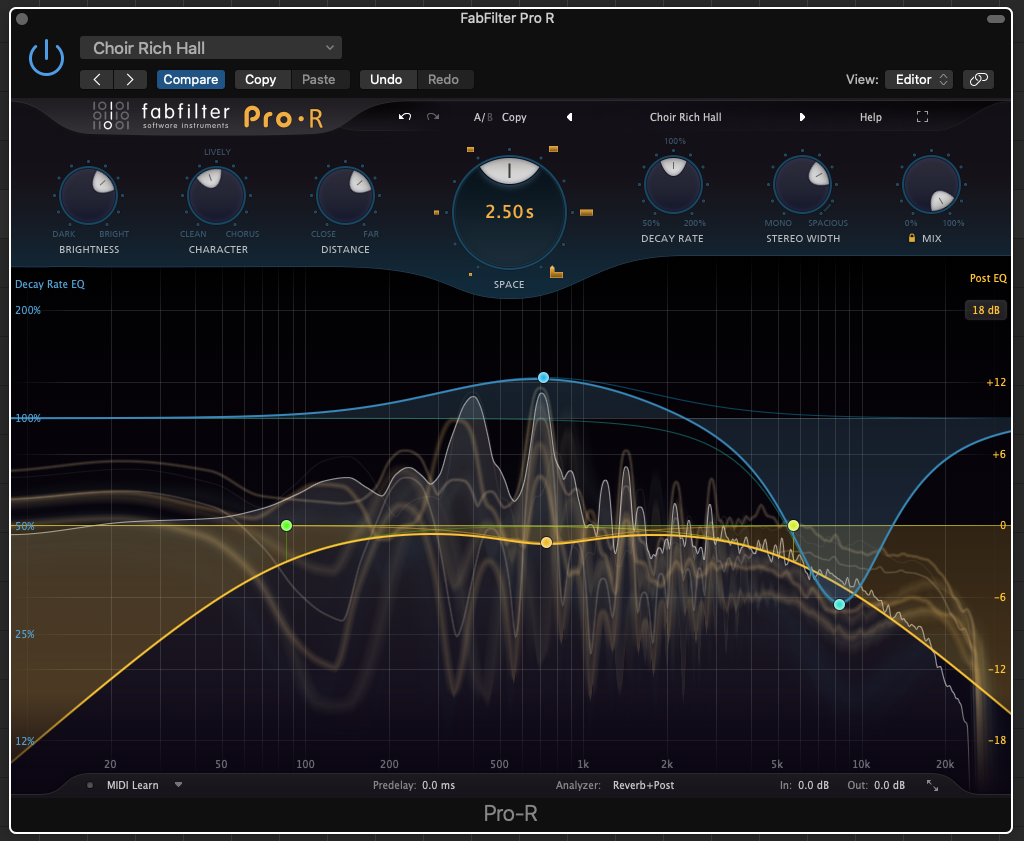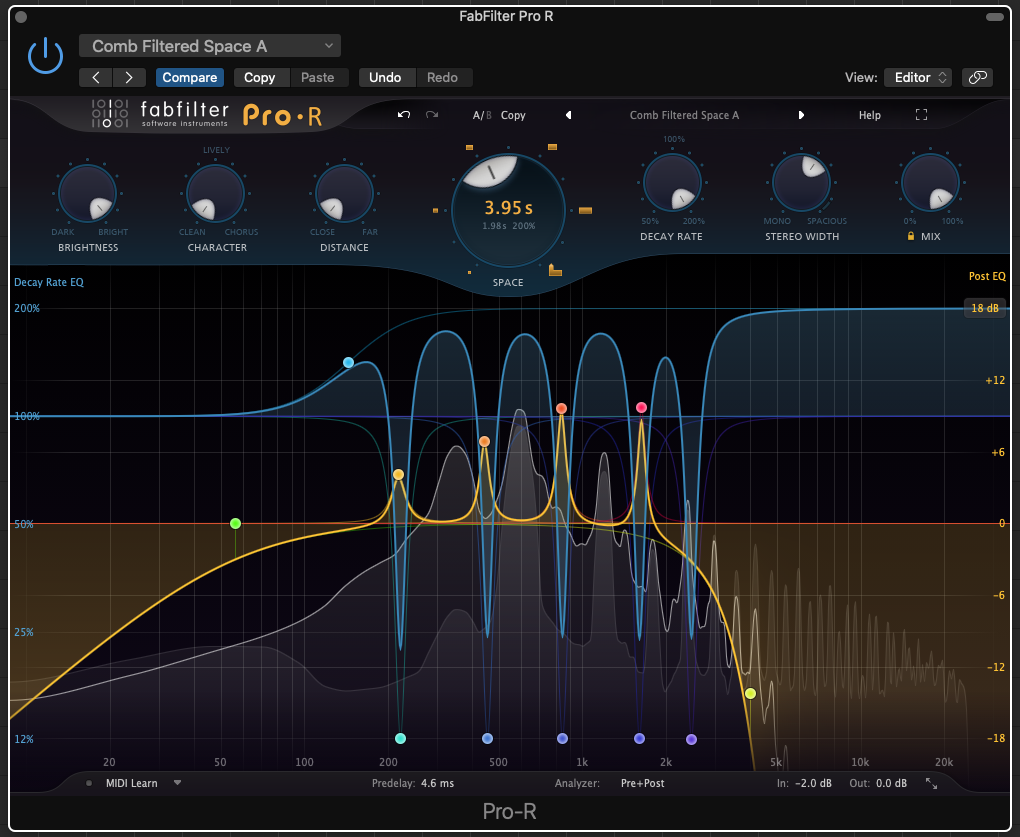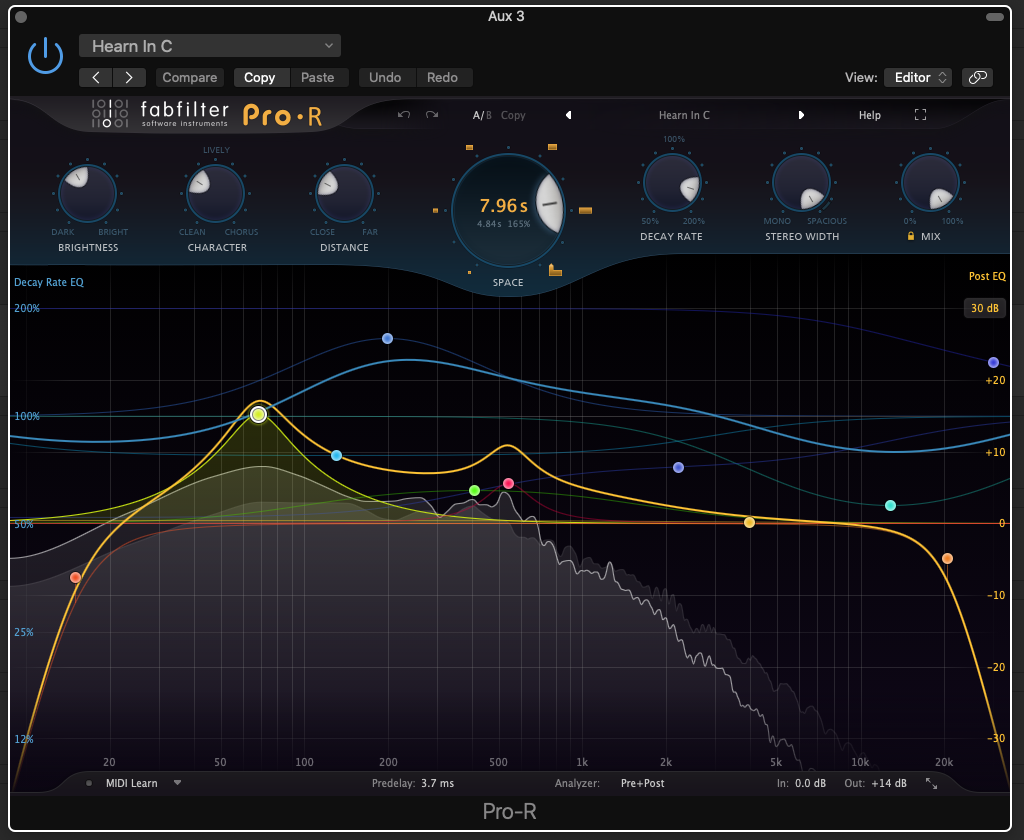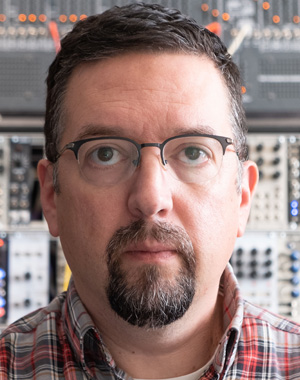FabFilter Pro•R
- March 2, 2021
- by Steve Castellano
- Product Intelligence Report
Reverb is such an ubiquitous effect that many of us wouldn’t dream of mixing without it. Our ears seem to crave it, for its lushness, the sense of space it creates, and the sense of power it can convey. The natural effect is chaos in action – thousands of echoes bouncing off various surfaces to create a hazy wash of sound. Emulating the real thing involves a lot of variables and a lot of math.
FabFilter Pro•R is an algorithmic reverb plugin that takes an innovative approach to taming this chaos. The interface features seven main controls and two EQ curves. The reverb it produces is exceptionally realistic, natural and creamy smooth, offering a distinct sense of space and what feels like an infinite range of malleability.

Main controls
While the main controls may not have all the labels you’re used to, their functions are self-explanatory. The main Space control allows you to morph seamlessly between six unnamed room types, as well as the decay time (from 200ms to 10s). Decay Rate allows you to stretch this from 50% to 200% without changing the room model. Brightness controls high/low frequency balance. Distance controls the perceived distance from the sound source, and the distribution of early reflections. Stereo Width takes you from mono through full stereo to “spacious” when fully clockwise.
The Character control is a little different, gradually altering the quality of your reverb from clean and transparent at 0% to a very interesting modulation effect as you dial it up past 50%. It’s a very musical alternative to traditional chorus effects, richer in some ways, subtler in others, never straying into over-the-top detuning. While most pronounced on sustained tones, I found it added a pleasant ensemble effect to shorter plucked sounds as well.
Sculpting your reverb
The majority of FabFilter Pro•R’s real estate is dedicated to a real-time spectral analyzer overlaid with Post EQ and Decay Rate EQ interfaces. While most reverb units offer some independent control over the decay time of two or three frequency ranges, and a few bands of post EQ, FabFilter Pro•R opens up a whole universe in which to sculpt and tweak your space.
Each EQ has six bands and is fully parametric. Post EQ allows you to sculpt the frequency content of your reverb with plenty of finesse, pinpointing and pulling down unwanted resonances, or emphasizing desirable ones. The range of control over individual bands is impressive. You can even specify frequencies by typing in MIDI note numbers, which can lead to some interesting harmonic sound design.

Decay Rate EQ adjusts the relative decay times of the harmonic content of your reverb, and this is where things can get really interesting. For example, in a traditional concert hall, you might expect higher frequencies to decay faster than lower ones. If, on the other hand, if you create a Decay Rate EQ curve that slopes upward to the right and inverts that relationship, you now have a reverb that seems to evaporate upward, evoking the characteristics of a high-domed cathedral.
Building a room
A few years back I went to an electronic music performance in a decommissioned power generating station – a huge, damp, cavernous space, with lots of concrete, glass, rusted metal and the occasional pool of stagnant water. It’s a space I’ve always wanted to try to duplicate, but I hadn’t quite managed it until I got my hands on FabFilter Pro•R.
Using a Moog Sub37 bassline as a sound source, I dialed up a 5 second decay time with the Space control, then extended it to 8 seconds with the Decay Rate. I added some high frequency content with about 40% Brightness before setting to work on the EQ curves. The UI is very quick to work with – double-click to create a band, drag to position, click once to open up a palette for selecting a curve or entering a value manually, and set Q with the mouse scroll wheel. In no time I’d set up a low and high shelf, a notch to pull out a bit of brashness from the midrange, and using the note-to-frequency feature, dropped in a boost at the root note of my bass loop.

I switched to the Decay Rate EQ curve and found a convincing band to accentuate the feeling of rusting steel and concrete, and increased the decay to about 150%, creating a gentle bell curve with highs and lows sloping down to 75%. I can’t go back to the Hearn to see how accurate my memory is, but I achieved the effect I heard in my head in record time.
Exiting reality
FabFilter Pro•R is primarily a linear reverb, so backwards reverb is off the table. In a brief quest for 80s-style processing I did manage to create a decent approximation of gated reverb by squeezing an already small room down with the Decay Rate. You can create spaces and effects that have no relation to real-world conditions, of course. FabFilter Pro•R is a lot of fun in that regard; just start grabbing curves and pushing things around. It’s very forgiving with respect to EQ gain, and in fact I had a hard time getting it to sound, well, bad.
Another option that encourages you to step out of the natural reverb space is Predelay Sync, which lets you sync the Predelay time to your song tempo. I tried it out with one of the 1/16th note presets on a stock breakbeat, and couldn’t resist using DAW control to automate some Post EQ frequencies over a two-bar pattern for an EDM filter-sweep effect. There’s clearly a lot of room here for exploration outside of the natural reverb space.
Conclusions
What I liked: With its friendly interface and exceptional EQ features, FabFilter Pro•R makes it very easy to create natural-sounding spaces that sit exactly where you need them in a mix. You can also push it to its limits to create otherworldly effects to complement your original sound design.
What I’d like to see: Having so much EQ control made me wish I had an input EQ feature as well, as I like to add some shelving EQ before my reverb. I also feel like Character could use an expert mode – it’s a very interesting effect but I’d love to tinker with it more than a single knob allows.
Overall: After just a few sessions, FabFilter Pro•R may have become my go-to reverb plugin. Between the interface and the quality of sound it’s capable of producing, it’s inspired me to think about reverb more as a compositional tool than simply a list of presets to flip through. This one is definitely worth checking out.
Author

Steve Castellano
Steve Castellano is a musician and writer living in Toronto, Canada. He holds a music degree from York University, where his focus was electronic music and composition. He currently records and performs modular electronic music under the name Elettronica Sperimentale.